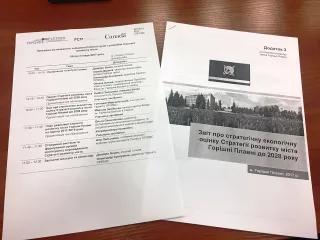
Heinrich Boell Foundation Regional Office in Ukraine together with the international technical assistance Project “Partnership for Local Economic Development and Democratic Governance”, implemented by the Federation of Canadian Municipalities, presented results of a Strategic Environmental Assessment (SEA) of the Horishni Plavni Development Strategy to 2028.
The process of preparing the Horishni Plavni Development Strategy to 2028 began in early 2017. At the same time it was decided to conduct the SEA of this strategy in order to anticipate the possible negative impacts from the implementation of the strategy, prevent them and ensure the environmentally friendly development of the city. In addition to this SEA allows to involve as many stakeholders as possible in choosing future development vectors.
Heinrich Boell Foundation Regional Office in Ukraine and international technical assistance Project “Partnership for Local Economic Development and Democratic Governance” decided to help in these processes to the city. Consultants Gennady Marushevsky and Maryana Zaviyska helped in attracting interested parties, briefed participants of the Working Group on the methodology of Strategic environmental assessment, organized the collection of data and generalized proposals and recommendations.
As a result, the SEA Working Group assessed the possible negative environmental impacts of the implementation of the Horishni Plavni Development Strategy to 2028 and made its recommendations more environmentally friendly. These results are documented in the Report on the SEA of the Development Strategy of the city of Horishni Plavni to 2028, which, together with the Strategy itself and its Implementation Plan, were presented at a broad meeting on November 8, 2017, and were submitted for further consideration to the city authorities.
According to the SEA, Horishni Plavni's development strategy is based on the principle of sustainable development, since the strategic directions of the city's development, as defined in the Strategy, cover the economic, environmental and social components of development. The strategy as a whole is aimed at reducing the technogenic impact on the environment, but the main anthropogenic factor of changes in the city remains the high level of development of enterprises of the mining and metallurgical industry. Implementation of the Development Strategy of the city of Horishni Plavni should not be accompanied by the emergence of new negative environmental impacts. At the same time, the implementation of many operational goals of the Strategy can lead to improvement of the ecological situation in the city. The text of the Strategic Environmental Assessment Report of the Horishni Plavni Development Strategy until 2028 can be found here.
Similar work with the support of the Heinrich Boell Foundation Regional Office in Ukraine and international technical assistance Project “Partnership for Local Economic Development and Democratic Governance” also takes place in two other cities: Kremenchuk (Poltava Region) and Khmilnyk (Vinnitsa Region). It is planned that the SEA reports will be presented in these cities by the end of 2017.
Reference: Strategic Environmental Assessment (SEA) is an assessment of the probable impact on the environment and public health from the implementation of the strategy / program / development plan in order to integrate the assessment results into the decision-making process and prevent the deterioration of the environment.
An appropriate Strategic Environmental Assessment Working Group was set up in each of the above mentioned cities, which included representatives of scientific institutions, public organizations, city authorities, as well as interested environmental and health authorities. The participants of SEA Working Groups assessed whether the implementation of the Development Strategy could lead to adverse environmental and climate impacts in each of the cities, and provided comments and recommendations to prevent this. Strategic environmental assessment allows to involve more stakeholders in the process of development of the City Development Strategies, to make it more participatory and democratic. Through the SEA, the public has an opportunity to participate in environmental decision-making, as well as access to environmental information in cities.